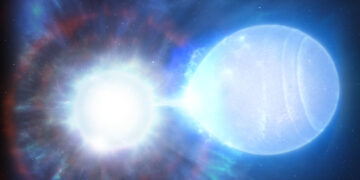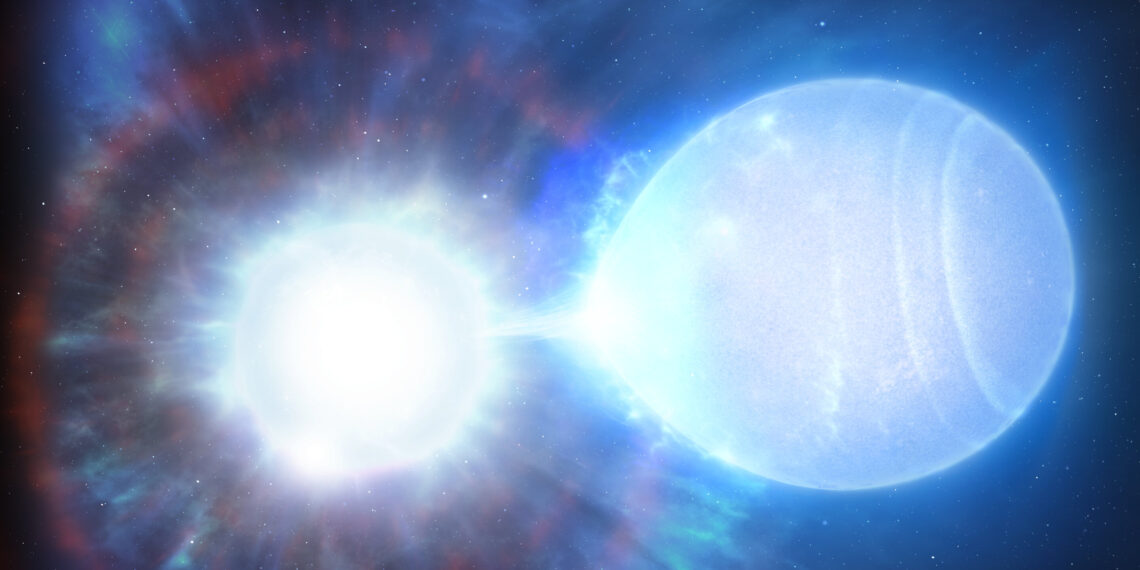Astronomers have made a jaw-dropping discovery that sounds like a plotline straight out of a science fiction novel: two white dwarf stars locked in a death spiral, heading toward an explosive finale that will light up the sky billions of years from now. But what’s truly astonishing is not just the violent end they face—it’s how close they are to Earth.
The Heart of the Discovery: A Pair Destined to Explode
The newly discovered system consists of two dense white dwarfs, remnants of stars that have exhausted their fuel and collapsed into hot, compact cores. What makes this system so fascinating is their unusually tight orbit, separated by only 1/60th the distance between Earth and the Sun—a proximity that means they are actively spiraling closer due to gravitational wave radiation.
Researchers led by James Munday, a Ph.D. student at Warwick, measured the system’s combined mass at 1.56 times that of the Sun, making it the heaviest known white dwarf binary to date. This is critical because when white dwarfs exceed the Chandrasekhar limit (approximately 1.4 solar masses), they can no longer support themselves against gravity and are destined to collapse—or explode.
This system guarantees such a fate. “When I first spotted this system with a very high total mass on our Galactic doorstep, I was immediately excited,” said Munday. Their findings, published in Nature Astronomy, confirm that the countdown to detonation has already begun.
A Closer Look at Type Ia Supernovae: Why They Matter So Much
In the cosmic realm, not all explosions are created equal—and Type Ia supernovae are in a class of their own. These are not just spectacular stellar events; they’re the cosmic yardsticks astronomers rely on to measure vast intergalactic distances. Known for their consistent peak brightness, Type Ia supernovae serve as “standard candles” to calculate how far away their host galaxies are from Earth.
For years, scientists have debated what exactly causes these explosions. The leading theory involves white dwarf binaries, where one star siphons mass from its companion until it reaches critical density and explodes. Yet, until now, astronomers had never directly observed a local system matching all the expected characteristics—a gap that this discovery now helps fill.
By identifying a double white dwarf binary with sufficient mass, close orbit, and realistic timeline, the University of Warwick team has offered compelling evidence that such systems are indeed progenitors of Type Ia supernovae.
How It Will Happen: A Countdown Measured in Billions
You might be wondering: if the supernova won’t happen for another 23 billion years, why should we care now?
Well, because we now know exactly how it will unfold.
Currently, the white dwarfs orbit each other every 14 hours. But as they emit gravitational waves, they lose energy and spiral ever closer. When they finally reach a separation small enough to complete an orbit in just 30–40 seconds, the real fireworks begin.
The expected explosion is known as a quadruple detonation supernova—a rare and complex sequence of explosive reactions. First, the outer layer of the more massive white dwarf detonates, followed by its core. That blast will hurl material into the second white dwarf, triggering two more detonations and completely annihilating the entire system.
And the result? A blaze of energy a thousand trillion trillion times stronger than the most powerful nuclear bomb. From Earth, this will appear as an ultra-bright star in the sky—10 times brighter than the full Moon, outshining even Jupiter by 200,000 times.
The Significance: A Missing Puzzle Piece in Supernova Science
This discovery is a big deal not just because it’s close, but because it confirms long-standing theoretical models. Astronomers have predicted for decades that double white dwarf systems should be common progenitors of Type Ia supernovae, yet observational evidence has been scarce.
Now, we finally have a direct example.
Dr. Ingrid Pelisoli, co-author of the study, noted that finding such a system so close suggests these pairs may be more common than we thought. That has huge implications. If more such systems are waiting to be discovered nearby, they could account for a significant fraction of all Type Ia supernovae in the Milky Way—allowing us to refine our models of cosmic distances and the universe’s expansion.
Moreover, this discovery opens up opportunities for multi-messenger astronomy, the study of celestial objects using not just light but gravitational waves as well. As these stars spiral inward, they’re emitting waves we may one day detect with instruments like LISA (Laser Interferometer Space Antenna)—providing yet another way to understand their evolution.
Should We Be Worried? Not at All.
Here’s the good news: despite its brightness, this supernova won’t harm Earth. At 150 light-years away, the system is far too distant to pose any threat, even at peak explosion.
Instead, it will offer a once-in-a-species spectacle, one that future humans—assuming we’re still around—could witness with the naked eye. It will dominate the night sky, casting eerie shadows and inspiring awe for months, perhaps years.
Conclusion: Cosmic Clarity from a Spiraling Pair
This discovery isn’t just about two stars caught in a dance of doom. It’s about connecting the dots in a cosmic story that’s puzzled astronomers for decades. It gives us proof of the process behind Type Ia supernovae, confirms the existence of ultra-massive compact binaries, and reminds us that the universe still holds surprises—right in our galactic backyard.
Reference:
Munday, J. et al. (2025). A super-Chandrasekhar mass type Ia supernova progenitor at 49 pc set to detonate in 23 Gyr, Nature Astronomy. DOI: 10.1038/s41550-025-02528-4

















